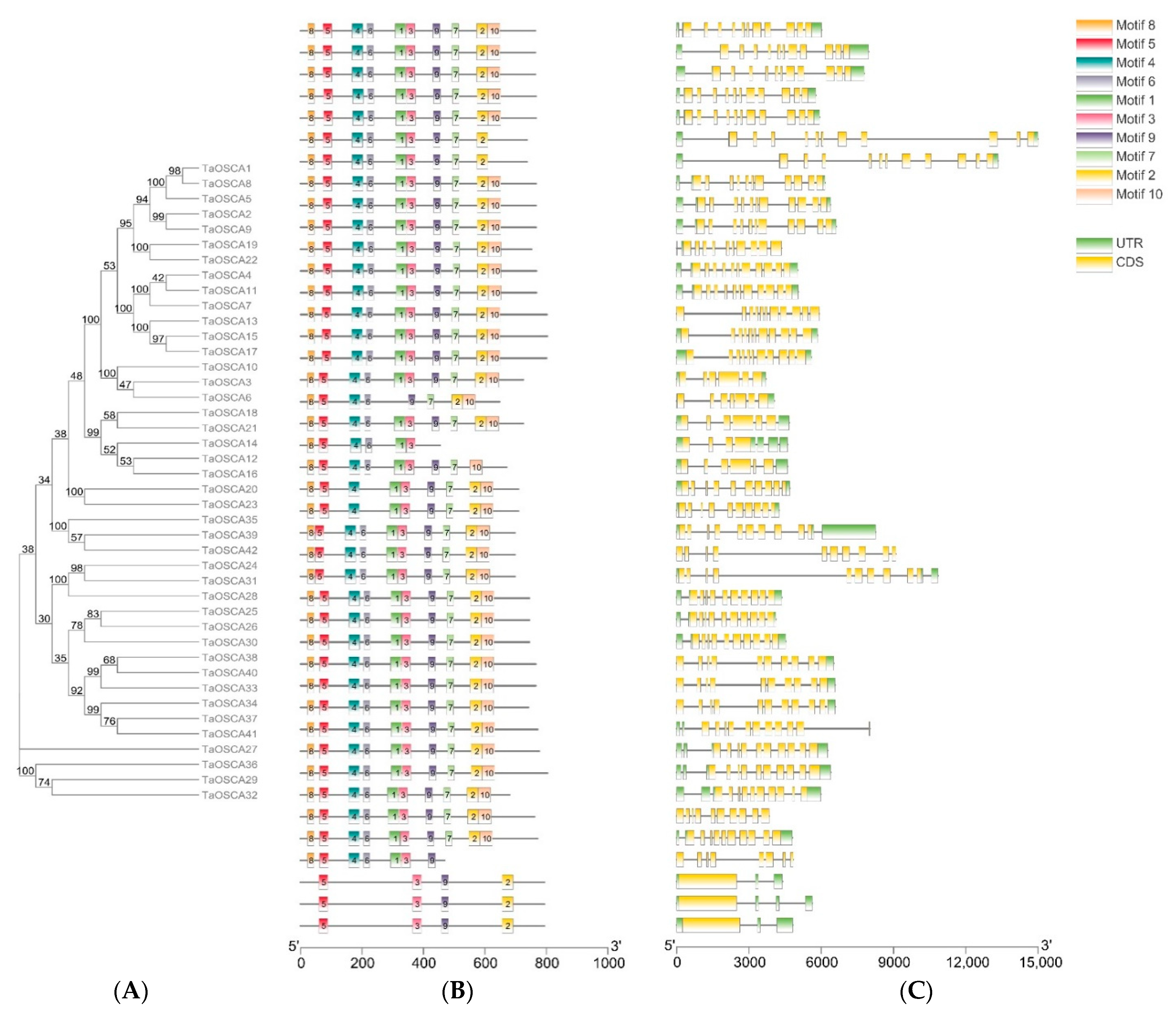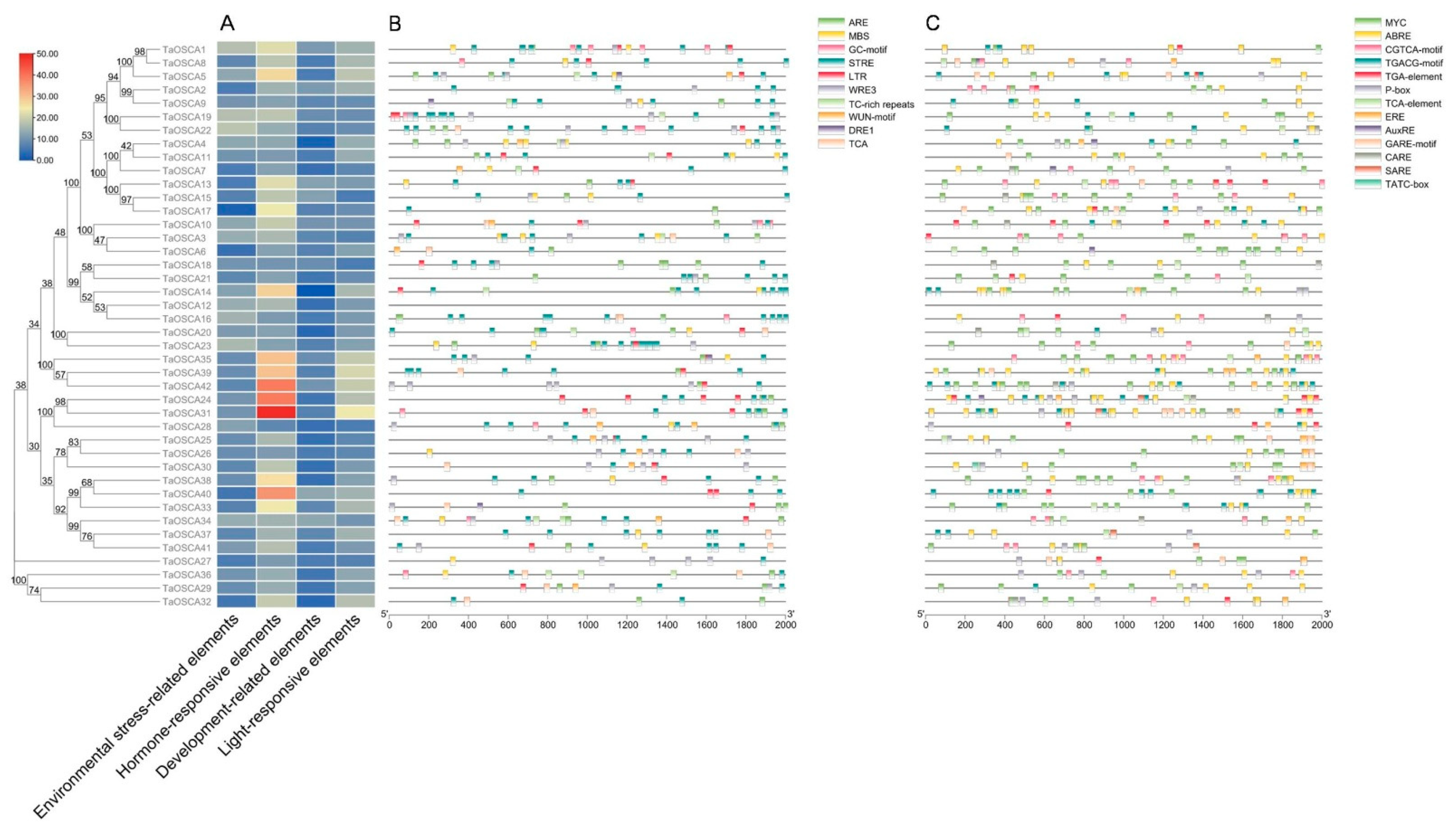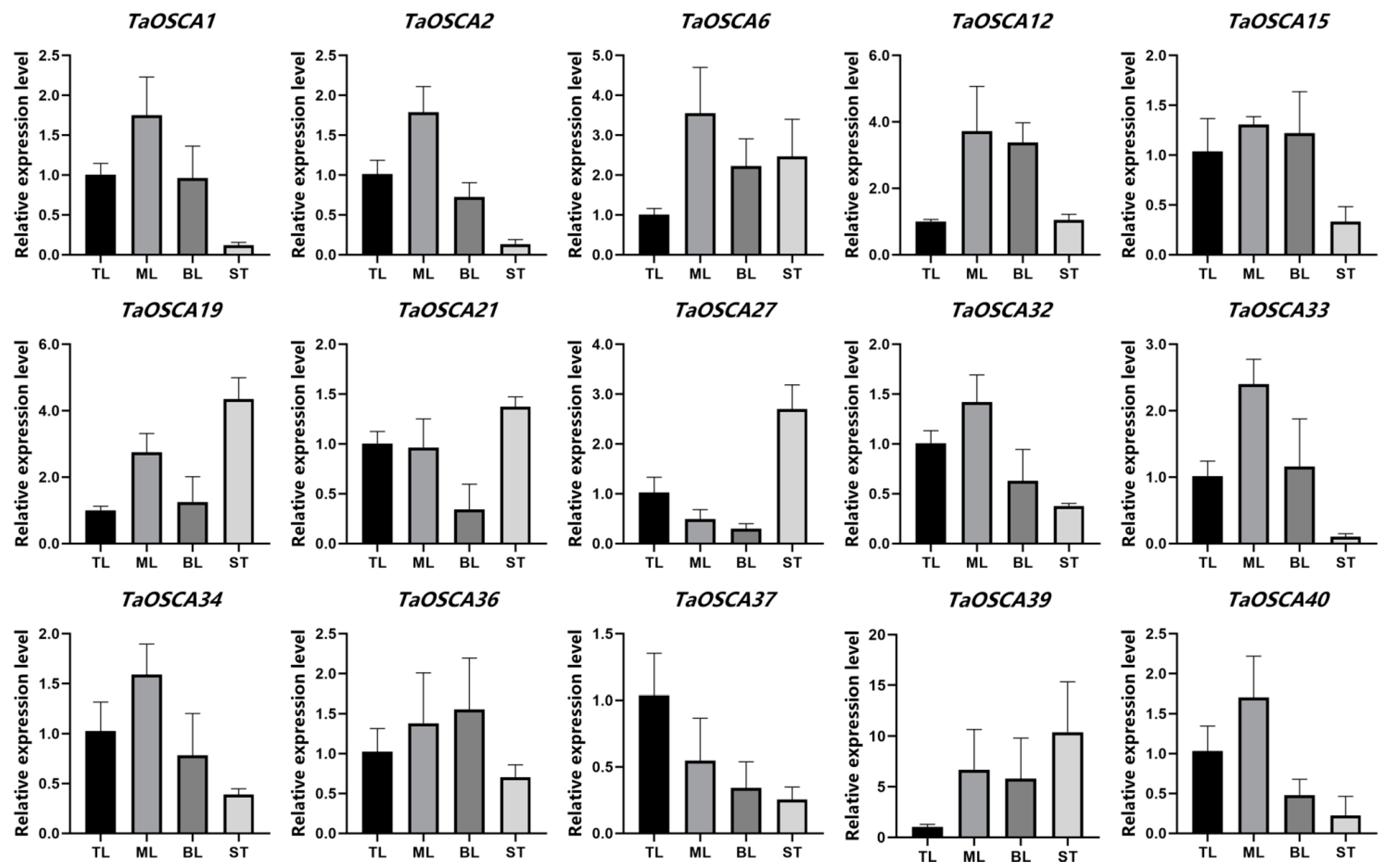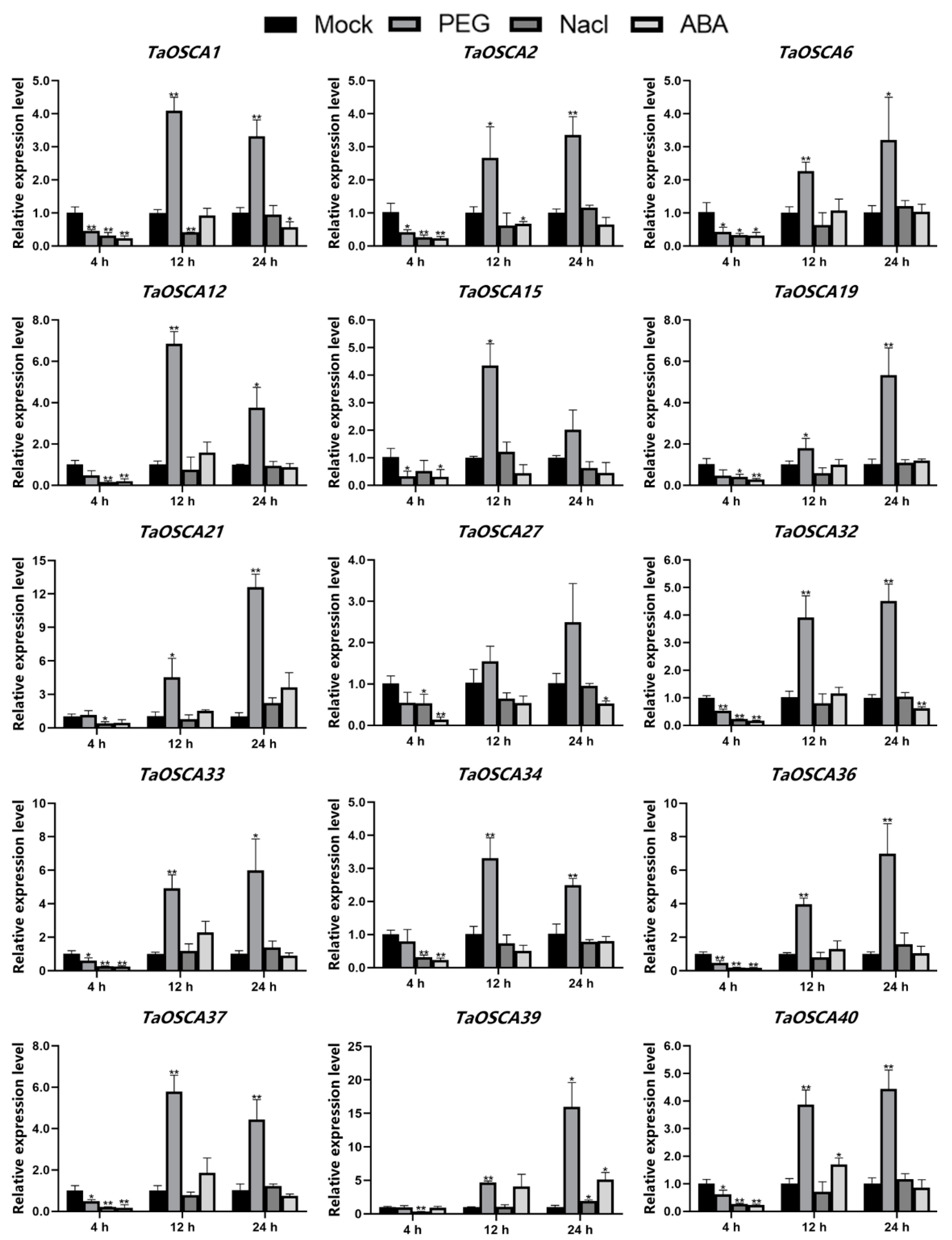Genome-Wide Identification and Expression Profile of OSCA Gene Family Members in Triticum aestivum L.
Abstract
:1. Introduction
2. Results
2.1. Genome-Wide Identification and Naming of TaOSCA Members
2.2. Phylogenetic Analysis
2.3. Analysis of TaOSCA Conserved Motifs, Gene Structure, and Domains
2.4. Prediction of Cis-Acting Elements of the TaOSCA Promoter
2.5. Expression Patterns of TaOSCA Genes in Different Tissues
2.6. Expression Profiles of TaOSCA Genes in Response to Abiotic Stress Treatments
3. Discussion
4. Materials and Methods
4.1. TaOSCA Gene Identification
4.2. Phylogenetic Analysis
4.3. Conserved Motifs, Gene Structure, and Functional Domain Analysis
4.4. Promoter Cis-Acting Element Prediction
4.5. Plant Materials and Abiotic Stress Treatments
4.6. RNA Isolation and Expression Analysis of TaOSCA Genes
5. Conclusions
Supplementary Materials
Author Contributions
Funding
Institutional Review Board Statement
Informed Consent Statement
Data Availability Statement
Acknowledgments
Conflicts of Interest
References
- Melotto, M.; Zhang, L.; Oblessuc, P.R.; He, S.Y. Stomatal defense a decade later. Plant Physiol. 2017, 174, 561–571. [Google Scholar] [CrossRef] [Green Version]
- Chen, X.; Ding, Y.; Yang, Y.; Song, C.; Wang, B.; Yang, S.; Guo, Y.; Gong, Z. Protein kinases in plant responses to drought, salt, and cold stress. J. Integr. Plant Biol. 2021, 63, 53–78. [Google Scholar] [CrossRef]
- Bartels, D.; Sunkar, R. Drought and salt tolerance in plants. CRC Crit. Rev. Plant Sci. 2005, 24, 23–58. [Google Scholar] [CrossRef]
- McAinsh, M.R.; Pittman, J.K. Shaping the calcium signature. New Phytol. 2009, 181, 275–294. [Google Scholar] [CrossRef] [PubMed]
- Kaur, H.; Sirhindi, G.; Bhardwaj, R.; Alyemeni, M.N.; Siddique, K.H.; Ahmad, P. 28-homobrassinolide regulates antioxidant enzyme activities and gene expression in response to salt and temperature-induced oxidative stress in Brassica juncea. Sci. Rep. 2018, 8, 8735. [Google Scholar] [CrossRef]
- Berridge, M.J.; Lipp, P.; Bootman, M.D. The versatility and universality of calcium signalling. Nat. Rev. Mol. Cell Biol. 2000, 1, 11–21. [Google Scholar] [CrossRef] [PubMed]
- Knight, H.; Trewavas, A.J.; Knight, M.R. Calcium signalling in Arabidopsis thaliana responding to drought and salinity. Plant J. 1997, 12, 1067–1078. [Google Scholar] [CrossRef]
- Dodd, A.N.; Kudla, J.; Sanders, D. The language of calcium signaling. Annu. Rev. Plant Biol. 2010, 61, 593–620. [Google Scholar] [CrossRef] [PubMed]
- Kung, C. A possible unifying principle for mechanosensation. Nature 2005, 436, 647–654. [Google Scholar] [CrossRef]
- Arnadottir, J.; Chalfie, M. Eukaryotic mechanosensitive channels. Annu. Rev. Biophys. 2010, 39, 111–137. [Google Scholar] [CrossRef]
- Zhu, J.K. Salt and drought stress signal transduction in plants. Annu. Rev. Plant Biol. 2002, 53, 247–273. [Google Scholar] [CrossRef] [PubMed] [Green Version]
- Monshausen, G.B.; Gilroy, S. Feeling green: Mechanosensing in plants. Trends Cell Biol. 2009, 19, 228–235. [Google Scholar] [CrossRef] [PubMed]
- Swarbreck, S.M.; Colaco, R.; Davies, J.M. Plant calcium-permeable channels. Plant Physiol. 2013, 163, 514–522. [Google Scholar] [CrossRef] [PubMed] [Green Version]
- Hou, C.; Tian, W.; Kleist, T.; He, K.; Garcia, V.; Bai, F.; Hao, Y.; Luan, S.; Li, L. DUF221 proteins are a family of osmosensitive calcium-permeable cation channels conserved across eukaryotes. Cell Res. 2014, 24, 632–635. [Google Scholar] [CrossRef] [PubMed] [Green Version]
- Yuan, F.; Yang, H.; Xue, Y.; Kong, D.; Ye, R.; Li, C.; Zhang, J.; Theprungsirikul, L.; Shrift, T.; Krichilsky, B.L.; et al. OSCA1 mediates osmotic-stress-evoked Ca2+ increases vital for osmosensing in Arabidopsis. Nature 2014, 514, 367–371. [Google Scholar] [CrossRef] [PubMed]
- Li, Y.; Yuan, F.; Wen, Z.; Li, Y.; Wang, F.; Zhu, T.; Zhuo, W.; Jin, X.; Wang, Y.; Zhao, H.; et al. Genome-wide survey and expression analysis of the OSCA gene family in rice. BMC Plant Biol. 2015, 15, 261. [Google Scholar] [CrossRef] [Green Version]
- Yin, L.; Zhang, M.; Wu, R.; Chen, X.; Liu, F.; Xing, B. Genome-wide analysis of OSCA gene family members in Vigna radiata and their involvement in the osmotic response. BMC Plant Biol. 2021, 21, 1–12. [Google Scholar] [CrossRef]
- Ding, S.; Feng, X.; Du, H.; Wang, H. Genome-wide analysis of maize OSCA family members and their involvement in drought stress. PeerJ 2019, 7, e6765. [Google Scholar] [CrossRef] [PubMed] [Green Version]
- Schroeder, B.C.; Cheng, T.; Jan, Y.N.; Jan, L.Y. Expression cloning of TMEM16A as a calcium-activated chloride channel subunit. Cell 2008, 134, 1019–1029. [Google Scholar] [CrossRef] [Green Version]
- Liu, X.; Wang, J.; Sun, L. Structure of the hyperosmolality-gated calcium-permeable channel OSCA1.2. Nat. Commun. 2018, 9, 5060. [Google Scholar] [CrossRef]
- Kiyosue, T.; Yamaguchi-Shinozaki, K.; Shinozaki, K. Cloning of cDNAs for genes that are early-responsive to dehydration stress (ERDs) in Arabidopsis thaliana L.: Identification of three ERDs as HSP cognate genes. Plant Mol. Biol. 1994, 25, 791–798. [Google Scholar] [PubMed]
- Sussmilch, F.C.; Schultz, J.; Hedrich, R.; Roelfsema, M.R.G. Acquiring control: The evolution of stomatal signalling pathways. Trends Plant. Sci. 2019, 24, 342–351. [Google Scholar] [CrossRef] [PubMed] [Green Version]
- Hedrich, R. Ion channels in plants. Physiol. Rev. 2012, 92, 1777–1811. [Google Scholar] [CrossRef] [PubMed]
- Jezek, M.; Blatt, M.R. The membrane transport system of the guard cell and its integration for stomatal dynamics. Plant Physiol. 2017, 174, 487–519. [Google Scholar] [CrossRef] [Green Version]
- Thor, K.; Jiang, S.; Michard, E.; George, J.; Scherzer, S.; Huang, S.; Dindas, J.; Derbyshire, P.; Leitão, N.; DeFalco, T.A.; et al. The calcium-permeable channel OSCA1.3 regulates plant stomatal immunity. Nature 2020, 585, 569–573. [Google Scholar] [CrossRef] [PubMed]
- Pfeifer, M.; Kugler, K.G.; Sandve, S.R.; Zhan, B.; Rudi, H.; Hvidsten, T.R.; Mayer, K.F.X.; Olsen, O.-A.; International Wheat Genome Sequencing Consortium. Genome interplay in the grain transcriptome of hexaploid bread wheat. Science 2014, 345, 1250091. [Google Scholar] [CrossRef] [PubMed] [Green Version]
- Wadskog, I.; Forsmark, A.; Rossi, G.; Konopka, C.; Öyen, M.; Goksör, M.; Ronne, H.; Brennwald, P.; Adler, L. The yeast tumor suppressor homologue Sro7p is required for targeting of the sodium pumping ATPase to the cell surface. Mol. Biol. Cell 2006, 17, 4988–5003. [Google Scholar] [CrossRef]
- Zhu, J.; Zhang, B.; Smith, E.N.; Drees, B.; Brem, R.B.; Kruglyak, L.; Bumgarner, R.E.; Schadt, E.E. Integrating large-scale functional genomic data to dissect the complexity of yeast regulatory networks. Nat. Genet. 2008, 40, 854–861. [Google Scholar] [CrossRef] [Green Version]
- Wang, W.; Vinocur, B.; Altman, A. Plant responses to drought, salinity and extreme temperatures: Towards genetic engineering for stress tolerance. Planta 2003, 218, 1–14. [Google Scholar] [CrossRef]
- Chen, K.; Li, G.J.; Bressan, R.A.; Song, C.P.; Zhu, J.K.; Zhao, Y. Abscisic acid dynamics, signaling, and functions in plants. J. Integr. Plant Biol. 2020, 62, 25–54. [Google Scholar] [CrossRef] [Green Version]
- Cutler, S.R.; Rodriguez, P.L.; Finkelstein, R.R.; Abrams, S.R. Abscisic acid: Emergence of a core signaling network. Annu. Rev. Plant Biol. 2010, 61, 651–679. [Google Scholar] [CrossRef] [Green Version]
- Kim, T.H.; Böhmer, M.; Hu, H.; Nishimura, N.; Schroeder, J.I. Guard cell signal transduction network: Advances in understanding abscisic acid, CO2, and Ca2+ signaling. Annu. Rev. Plant Biol. 2010, 61, 561–591. [Google Scholar] [CrossRef] [PubMed] [Green Version]
- Lescot, M.; Déhais, P.; Thijs, G.; Marchal, K.; Moreau, Y.; Van de Peer, Y.; Rouze, P.; Rombauts, S. PlantCARE, a database of plant cis-acting regulatory elements and a portal to tools for in silico analysis of promoter sequences. Nucleic Acids Res. 2002, 30, 325–327. [Google Scholar] [CrossRef] [PubMed]
- Wu, X.; Lai, Y.; Lv, L.; Ji, M.; Han, K.; Yan, D.; Lu, Y.; Peng, J.; Rao, S.; Yan, F.; et al. Fasciclin-like arabinogalactan gene family in Nicotiana benthamiana: Genome-wide identification, classification and expression in response to pathogens. BMC Plant Biol. 2020, 20, 305. [Google Scholar] [CrossRef] [PubMed]
- Chen, X.; Wu, X.; Qiu, S.; Zheng, H.; Lu, Y.; Peng, J.; Wu, G.; Chen, J.; Rao, S.; Yan, F. Genome-wide identification and expression profiling of the BZR transcription factor gene family in Nicotiana benthamiana. Int. J. Mol. Sci. 2021, 22, 10379. [Google Scholar] [CrossRef]
- Chen, C.; Chen, H.; Zhang, Y.; Thomas, H.R.; Frank, M.H.; He, Y.; Xia, R. TBtools: An integrative toolkit developed for interactive analyses of big biological data. Mol. Plant 2020, 13, 1194–1202. [Google Scholar] [CrossRef]
- Wilkins, M.R.; Gasteiger, E.; Bairoch, A.; Sanchez, J.-C.; Williams, K.L.; Appel, R.D.; Hochstrasser, D.F. Protein identification and analysis tools in the ExPASy server. Methods Mol. Biol. 1999, 112, 531–552. [Google Scholar]
- Kumar, S.; Stecher, G.; Li, M.; Knyaz, C.; Tamura, K. MEGA X: Molecular evolutionary genetics analysis across computing platforms. Mol. Biol. Evol. 2018, 35, 1547–1549. [Google Scholar] [CrossRef]
- Bailey, T.L.; Boden, M.; Buske, F.A.; Frith, M.; Grant, C.E.; Clementi, L.; Ren, J.; Li, W.W.; Noble, W.S. MEME Suite: Tools for motif discovery and searching. Nucleic Acids Res. 2009, 37, W202–W208. [Google Scholar] [CrossRef]
- He, L.; Chen, X.; Xu, M.; Liu, T.; Zhang, T.; Li, J.; Yang, J.; Chen, J.; Zhong, K. Genome-wide identification and characterization of the cystatin gene family in bread wheat (Triticum aestivum L.). Int. J. Mol. Sci. 2021, 22, 264. [Google Scholar] [CrossRef]
- Livak, K.J.; Schmittgen, T.D. Analysis of relative gene expression data using real-time quantitative PCR and the 2−ΔΔCT Method. Methods 2001, 25, 402–408. [Google Scholar] [CrossRef] [PubMed]






| Gene Symbol | Gene Locus | Chromosome Position | CDS (bp) | Protein Length (aa) | Theoretical PI | Molecular Weight (kDa) |
|---|---|---|---|---|---|---|
| TaOSCA1 | TraesCS1A02G029300.1 | 1A:13762566:13768572 | 2295 | 764 | 8.94 | 87.7 |
| TaOSCA2 | TraesCS1A02G034100.1 | 1A:16913591:16919361 | 2301 | 766 | 9.06 | 87.9 |
| TaOSCA3 | TraesCS1A02G196800.1 | 1A:354950050:354955890 | 2412 | 803 | 9.15 | 93.4 |
| TaOSCA4 | TraesCS1A02G247300.1 | 1A:438692887:438699043 | 2304 | 767 | 7.33 | 87.6 |
| TaOSCA5 | TraesCS1B02G036500.1 | 1B:17379054:17386839 | 2295 | 764 | 8.81 | 87.8 |
| TaOSCA6 | TraesCS1B02G211400.1 | 1B:384496418:384502005 | 2406 | 801 | 9.12 | 93.1 |
| TaOSCA7 | TraesCS1B02G257900.1 | 1B:453873827:453880440 | 2304 | 767 | 7.73 | 87.6 |
| TaOSCA8 | TraesCS1D02G029500.1 | 1D:11616634:11624592 | 2295 | 764 | 8.87 | 87.8 |
| TaOSCA9 | TraesCS1D02G035600.1 | 1D:16402928:16408856 | 2301 | 766 | 9.09 | 87.9 |
| TaOSCA10 | TraesCS1D02G200300.1 | 1D:282959933:282965842 | 2409 | 802 | 9.16 | 93.2 |
| TaOSCA11 | TraesCS1D02G246500.1 | 1D:339106416:339112794 | 2301 | 766 | 7.73 | 87.5 |
| TaOSCA12 | TraesCS2A02G252100.1 | 2A:383596822:383601415 | 2097 | 698 | 9.17 | 78.1 |
| TaOSCA13 | TraesCS2A02G262100.1 | 2A:413328225:413332576 | 2259 | 752 | 8.83 | 85.1 |
| TaOSCA14 | TraesCS2B02G271900.1 | 2B:373476491:373481152 | 2178 | 725 | 9.29 | 81.2 |
| TaOSCA15 | TraesCS2B02G280100.1 | 2B:386306102:386311122 | 2307 | 768 | 6.59 | 87.4 |
| TaOSCA16 | TraesCS2D02G252800.1 | 2D:304963347:304967946 | 2016 | 671 | 9.27 | 75.4 |
| TaOSCA17 | TraesCS2D02G261900.1 | 2D:318328838:318333878 | 2307 | 768 | 6.72 | 87.4 |
| TaOSCA18 | TraesCS3A02G019900.1 | 3A:11891585:11895285 | 2178 | 725 | 9.42 | 81.7 |
| TaOSCA19 | TraesCS3B02G231400.1 | 3B:349934463:349949455 | 2214 | 737 | 8.58 | 84.3 |
| TaOSCA20 | TraesCS3B02G541500.1 | 3B:779622377:779627065 | 2130 | 709 | 8.97 | 80.0 |
| TaOSCA21 | TraesCS3D02G026700.1 | 3D:9094139:9098190 | 1947 | 648 | 9.51 | 72.5 |
| TaOSCA22 | TraesCS3D02G201300.1 | 3D:238617165:238630499 | 2214 | 737 | 8.58 | 84.2 |
| TaOSCA23 | TraesCS3D02G485000.1 | 3D:581939165:581943412 | 2130 | 709 | 9.01 | 80.1 |
| TaOSCA24 | TraesCS4A02G257600.1 | 4A:570460851:570465209 | 2238 | 745 | 8.89 | 85.7 |
| TaOSCA25 | TraesCS4A02G291700.1 | 4A:594680010:594686528 | 2301 | 766 | 9.33 | 87.0 |
| TaOSCA26 | TraesCS4B02G022300.1 | 4B:16056589:16063157 | 2301 | 766 | 9.44 | 86.8 |
| TaOSCA27 | TraesCS4B02G023400.1 | 4B:17037475:17042314 | 1410 | 469 | 9.77 | 53.7 |
| TaOSCA28 | TraesCS4B02G056900.1 | 4B:46623552:46628077 | 2238 | 745 | 8.84 | 85.7 |
| TaOSCA29 | TraesCS4B02G335800.1 | 4B:627519072:627524699 | 2385 | 794 | 7.2 | 89.6 |
| TaOSCA30 | TraesCS4D02G020100.1 | 4D:8653451:8660027 | 2229 | 742 | 9.13 | 84.3 |
| TaOSCA31 | TraesCS4D02G057200.1 | 4D:32238120:32242237 | 2238 | 745 | 8.84 | 85.7 |
| TaOSCA32 | TraesCS4D02G331300.1 | 4D:489186164:489190977 | 2385 | 794 | 7.55 | 89.5 |
| TaOSCA33 | TraesCS5A02G012500.1 | 5A:8233156:8239545 | 2415 | 804 | 9.07 | 90.7 |
| TaOSCA34 | TraesCS5A02G012600.1 | 5A:8240521:8246498 | 2043 | 680 | 8.04 | 77.2 |
| TaOSCA35 | TraesCS5A02G071400.1 | 5A:80159622:80167881 | 2097 | 698 | 8.71 | 78.9 |
| TaOSCA36 | TraesCS5A02G505500.1 | 5A:670818817:670823201 | 2385 | 794 | 7.55 | 89.6 |
| TaOSCA37 | TraesCS5B02G010700.1 | 5B:10438285:10442125 | 2286 | 761 | 8.96 | 86.3 |
| TaOSCA38 | TraesCS5B02G010800.1 | 5B:10442174:10450187 | 2319 | 772 | 9.07 | 87.4 |
| TaOSCA39 | TraesCS5B02G077400.1 | 5B:93218161:93227257 | 2094 | 697 | 8.62 | 79.1 |
| TaOSCA40 | TraesCS5D02G018000.1 | 5D:10520893:10527152 | 2334 | 777 | 9.08 | 88.1 |
| TaOSCA41 | TraesCS5D02G018100.1 | 5D:10537542:10542334 | 2316 | 771 | 8.61 | 87.4 |
| TaOSCA42 | TraesCS5D02G083600.1 | 5D:87182360:87193201 | 2097 | 698 | 8.79 | 79.0 |
Publisher’s Note: MDPI stays neutral with regard to jurisdictional claims in published maps and institutional affiliations. |
© 2021 by the authors. Licensee MDPI, Basel, Switzerland. This article is an open access article distributed under the terms and conditions of the Creative Commons Attribution (CC BY) license (https://creativecommons.org/licenses/by/4.0/).
Share and Cite
Tong, K.; Wu, X.; He, L.; Qiu, S.; Liu, S.; Cai, L.; Rao, S.; Chen, J. Genome-Wide Identification and Expression Profile of OSCA Gene Family Members in Triticum aestivum L. Int. J. Mol. Sci. 2022, 23, 469. https://doi.org/10.3390/ijms23010469
Tong K, Wu X, He L, Qiu S, Liu S, Cai L, Rao S, Chen J. Genome-Wide Identification and Expression Profile of OSCA Gene Family Members in Triticum aestivum L. International Journal of Molecular Sciences. 2022; 23(1):469. https://doi.org/10.3390/ijms23010469
Chicago/Turabian StyleTong, Kai, Xinyang Wu, Long He, Shiyou Qiu, Shuang Liu, Linna Cai, Shaofei Rao, and Jianping Chen. 2022. "Genome-Wide Identification and Expression Profile of OSCA Gene Family Members in Triticum aestivum L." International Journal of Molecular Sciences 23, no. 1: 469. https://doi.org/10.3390/ijms23010469






